Are you curious about the number of carbs in your favorite Chicken Caesar Salad? It’s always good to know the nutritional value of the food we enjoy. In this article, I will delve into the carbohydrate content of a Chicken Caesar Salad and discuss its overall nutritional profile. Let’s uncover the truth behind those delicious greens!
- A Chicken Caesar Salad typically contains 5 grams of carbohydrates per 100 grams.
- The salad provides 12 grams of protein, 14 grams of fat, and 1 gram of sugar.
- It is a good source of calcium and iron, with 150 milligrams and 0.72 milligrams, respectively.
- Simple modifications can help reduce the calorie and fat content of the salad, such as opting for low-fat dressing or grilled chicken.
- Some restaurant versions of the Caesar Salad may have higher calorie and fat content, so it’s important to check the nutrition information.
A Chicken Caesar Salad can be a healthy and delicious meal option when mindful choices are made. Let’s explore the carbs and nutritional value of this classic salad together!
Understanding the Carbs in a Chicken Caesar Salad
A typical Chicken Caesar Salad contains approximately 5 grams of carbohydrates per 100 grams. This makes it a relatively low-carb option, especially when compared to other salad choices. Carbohydrates are an important source of energy for our bodies, but it’s essential to be mindful of our intake, especially if we are following a low-carb diet.
When it comes to a low-carb Chicken Caesar Salad, there are a few simple modifications you can make to reduce the carb content even further. For example, you can opt for romaine lettuce instead of croutons or use a low-carb dressing. Additionally, you can add more protein to your salad by including grilled chicken breast or boiled eggs. These modifications not only decrease the carb count but also provide a more balanced macronutrient profile.
Low-Carb Ingredients for a Healthier Chicken Caesar Salad
Here are some low-carb ingredients you can incorporate into your Chicken Caesar Salad:
- Romaine lettuce or mixed greens
- Grilled chicken breast or boiled eggs for added protein
- Shredded Parmesan cheese
- Sugar-free Caesar dressing or a homemade dressing with olive oil and lemon
- Optional additions: cherry tomatoes, cucumber slices, or avocado
With these substitutions and additions, you can create a delicious and satisfying low-carb Chicken Caesar Salad that fits well into your dietary goals. Remember to check the nutrition information of any restaurant versions of the Caesar Salad, as they may vary in terms of calorie and fat content. Making informed choices and customizing your salad to suit your preferences can help you enjoy a healthier and more fulfilling meal.
| Nutrition | Per 100 grams |
|---|---|
| Carbohydrates | 5 grams |
| Protein | 12 grams |
| Fat | 14 grams |
| Sugar | 1 gram |
Nutritional Profile of a Chicken Caesar Salad
Apart from carbohydrates, a Chicken Caesar Salad offers 12 grams of protein, 14 grams of fat, and 1 gram of sugar. It is also a good source of calcium and iron, providing 150 milligrams and 0.72 milligrams, respectively.
Protein is an essential nutrient that plays a crucial role in building and repairing tissues, supporting immune function, and providing energy. With 12 grams of protein, a Chicken Caesar Salad can contribute to meeting your daily protein needs.
Fat is another important macronutrient that provides energy, aids in nutrient absorption, and helps regulate body temperature. While a Chicken Caesar Salad contains 14 grams of fat, it’s worth noting that not all fats are created equal. Opt for healthier fat options, such as olive oil-based dressings, to maximize the nutritional benefits of your salad.
Additionally, a Chicken Caesar Salad contains 1 gram of sugar, making it a low-sugar option compared to many other popular salad choices. This can be particularly beneficial for individuals looking to reduce their sugar intake or manage their blood sugar levels.
| Nutrient | Amount per 100g |
|---|---|
| Carbohydrates | 5g |
| Protein | 12g |
| Fat | 14g |
| Sugar | 1g |
| Calcium | 150mg |
| Iron | 0.72mg |
With its balanced macronutrient profile and notable calcium and iron content, a Chicken Caesar Salad can be a nutritious choice for a satisfying meal. However, it’s important to be mindful of portion sizes and the types of ingredients used, as these can greatly impact the overall nutritional value of your salad. Making simple modifications such as using low-fat dressing or opting for grilled chicken can help reduce the calorie and fat content without compromising on taste.
Remember, not all Chicken Caesar Salads are created equal. Some restaurant versions may have higher calorie and fat content, so it’s always a good idea to check the nutrition information before ordering.
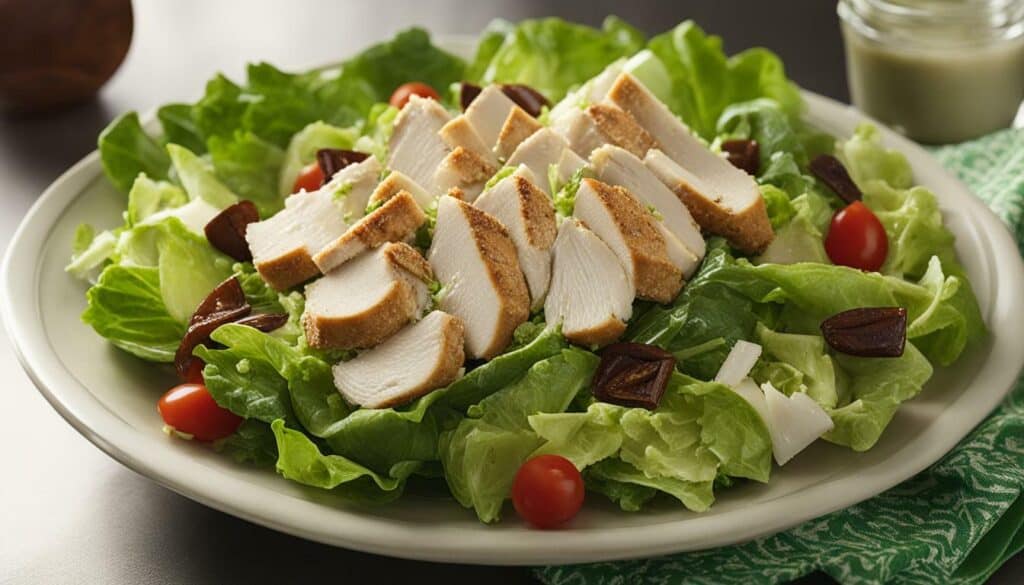
To make the most of the nutritional benefits of a Chicken Caesar Salad, consider adding nutrient-dense toppings such as cherry tomatoes, avocado slices, or boiled eggs. These additions can enhance the salad’s vitamin and mineral content, making it even more nourishing.
- Cherry tomatoes are rich in lycopene, a powerful antioxidant that may help protect against certain types of cancer.
- Avocado provides heart-healthy monounsaturated fats and is a good source of vitamins C, E, and K.
- Boiled eggs are an excellent source of high-quality protein, vitamins, and minerals, including vitamin D and choline.
“A Chicken Caesar Salad can be a delicious and nutritious option when made with fresh ingredients and mindful choices.” – Me
Making Healthier Choices
By making simple modifications, such as using low-fat dressing or opting for grilled chicken, you can reduce the calorie and fat content of your Chicken Caesar Salad. Making these changes doesn’t mean sacrificing flavor or enjoyment. In fact, it can enhance the overall taste and make your salad a healthier option for your diet.
One of the easiest ways to lighten up your Chicken Caesar Salad is by choosing a low-fat or light dressing. These alternatives typically have fewer calories and less fat compared to traditional Caesar dressing, without compromising on taste. You can still enjoy the creamy texture and tangy flavor while reducing unnecessary calories.
Another modification you can make is to swap out fried chicken for grilled chicken. Grilled chicken is a leaner protein option that is lower in calories and saturated fat. Not only does it reduce the overall fat content of your salad, but it also adds a delicious smoky flavor that pairs well with the other ingredients.
| Ingredient | Calories (per 100g) | Fat (per 100g) |
|---|---|---|
| Romaine Lettuce | 17 | 0.2g |
| Grilled Chicken | 165 | 3.6g |
| Low-Fat Caesar Dressing | 70 | 3g |
| Parmesan Cheese | 420 | 38g |
Remember, it’s important to pay attention to portion sizes and avoid excessive amounts of dressing or cheese, as they can quickly add calories and fat to your salad.
By incorporating these healthier choices into your Chicken Caesar Salad, you can create a satisfying and nutritious meal that aligns with your health goals. With fewer calories and less fat, you can enjoy a guilt-free salad that doesn’t compromise on taste. So go ahead and indulge in a delicious and healthy Chicken Caesar Salad!
Check the Nutrition Information
When ordering a Chicken Caesar Salad at a restaurant, it’s essential to review the nutrition information for any variations in calorie and fat content. While a Chicken Caesar Salad typically contains 5 grams of carbohydrates per 100 grams, other factors such as the dressing, toppings, and preparation method can significantly affect its nutritional value.
To make healthier choices, consider using low-fat dressing or opting for grilled chicken instead of fried. These simple modifications can help reduce the calorie and fat content while still allowing you to enjoy the flavors of a classic Chicken Caesar Salad.
It’s important to note that some restaurant versions of the Caesar Salad may have higher calorie and fat content compared to homemade options. By checking the nutrition information provided, you can make informed decisions that align with your dietary goals.
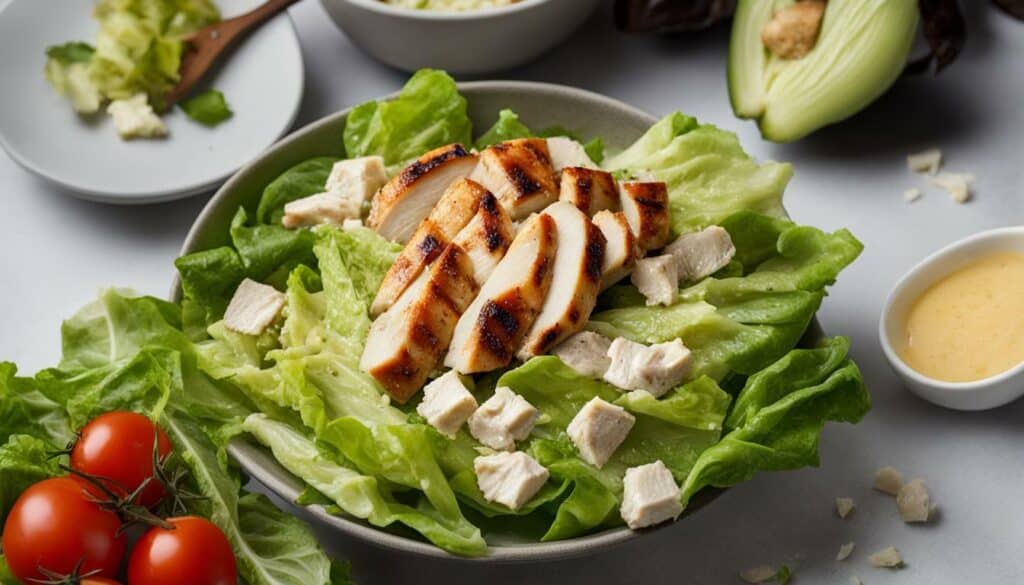
| Nutrient | Amount per 100g |
|---|---|
| Carbohydrates | 5g |
| Protein | 12g |
| Fat | 14g |
| Sugar | 1g |
| Calcium | 150mg |
| Iron | 0.72mg |
With its balanced macronutrient profile and good source of calcium and iron, a Chicken Caesar Salad can be a healthy and delicious meal option. By making mindful choices and considering the nutritional facts, you can confidently enjoy this classic salad without compromising your dietary goals.
Benefits of a Chicken Caesar Salad
A Chicken Caesar Salad can be a good source of calcium, providing around 150 milligrams, as well as a source of iron, with approximately 0.72 milligrams. These essential minerals play vital roles in maintaining overall health and well-being.
Calcium is important for building and maintaining strong bones and teeth, while also supporting proper muscle and nerve function. It is especially crucial during childhood and adolescence when bone growth and development are at their peak. Iron, on the other hand, is essential for the production of red blood cells, which transport oxygen throughout the body and play a key role in energy production.
Additionally, a Chicken Caesar Salad offers a combination of other important nutrients. With its generous serving of fresh lettuce, this salad is rich in dietary fiber, which aids digestion and helps regulate blood sugar levels. The grilled chicken provides a lean source of protein, which helps build and repair tissues, supports immune function, and provides a feeling of fullness.
By incorporating a variety of vegetables, such as cherry tomatoes or sliced bell peppers, a Chicken Caesar Salad can also provide an array of vitamins and antioxidants, promoting overall health and protecting against oxidative stress.
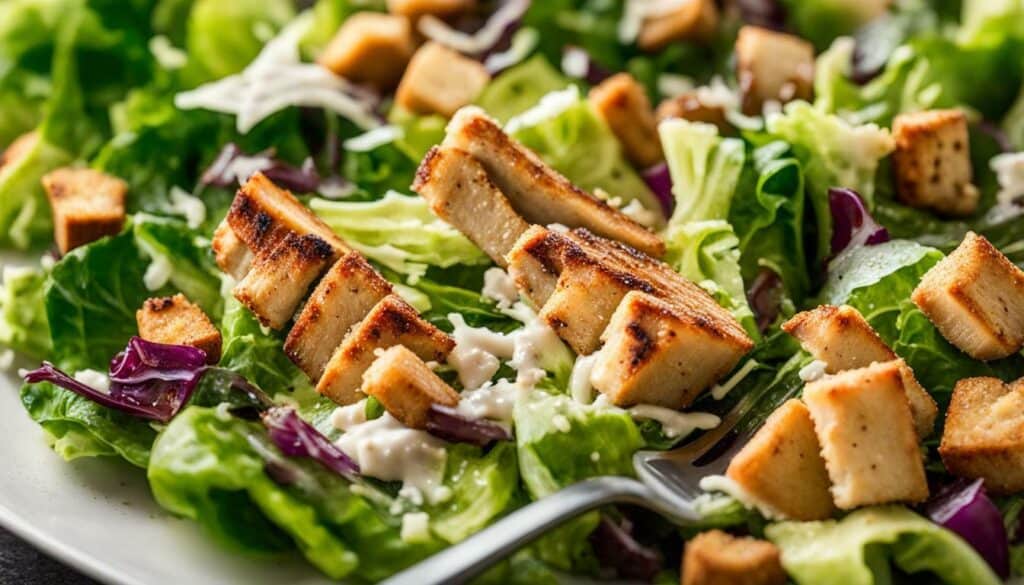
Creating a nutritious and satisfying Chicken Caesar Salad is easy. Simply combine fresh romaine lettuce, grilled chicken breast, Parmesan cheese, and a tangy Caesar dressing. To reduce calories and fat, opt for a low-fat or light dressing and use a moderate amount to control portion sizes. You can also experiment with different protein options, such as shrimp or tofu, for added variety.
In conclusion, a Chicken Caesar Salad can be a delicious and healthy choice when mindful choices are made. With its calcium and iron content, along with a range of other essential nutrients, this salad offers a nutritious and satisfying meal option. By making simple modifications and being mindful of portion sizes, you can enjoy a Chicken Caesar Salad that is both wholesome and delicious.
Tips for a Keto-Friendly Chicken Caesar Salad
If you follow a keto diet, you can still enjoy a Chicken Caesar Salad by opting for low-carb dressing and incorporating keto-friendly ingredients. The traditional Caesar dressing is typically made with mayonnaise, garlic, anchovies, and Parmesan cheese, which can be high in carbs. However, you can easily swap it out for a homemade dressing using olive oil, lemon juice, Dijon mustard, and minced garlic. This low-carb dressing will provide a creamy and tangy flavor without compromising your keto goals.
When it comes to the other ingredients in your Chicken Caesar Salad, there are a few modifications you can make to keep it keto-friendly. Instead of croutons, which are high in carbs, try adding some toasted almonds or crushed pork rinds for a crunchy texture. You can also enhance the salad with keto-approved toppings such as avocado, bacon, and shredded Parmesan cheese.
For the protein element of your keto-friendly Chicken Caesar Salad, opt for grilled chicken breast instead of breaded or fried chicken. Grilled chicken is low in carbs and provides a good source of lean protein, which is essential for a keto diet. To add even more variety to your salad, you can experiment with other keto-friendly proteins like grilled shrimp or salmon.
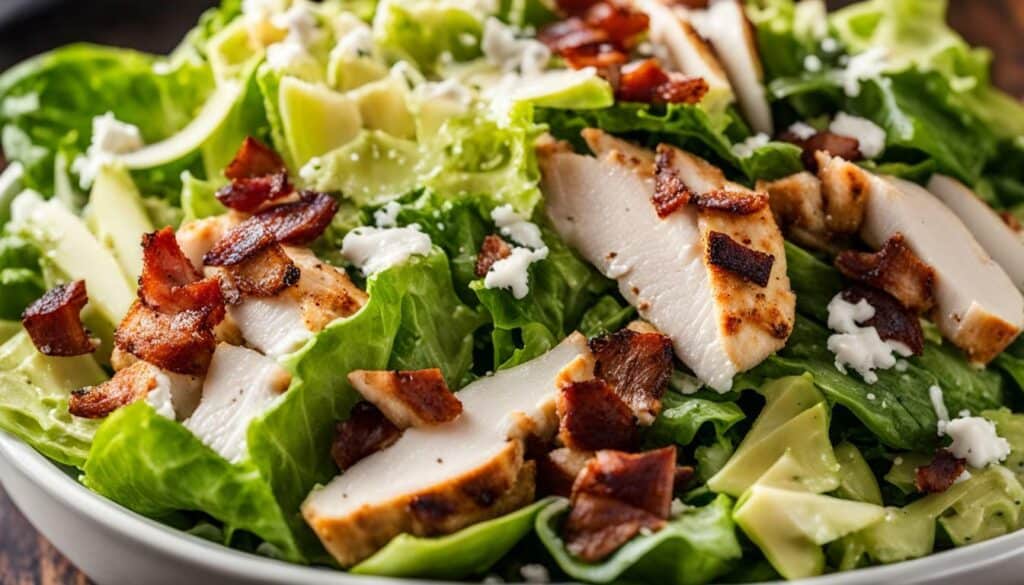
| Ingredients | Amount |
|---|---|
| Romaine lettuce | 2 cups |
| Grilled chicken breast | 4 ounces |
| Cherry tomatoes | 1/2 cup |
| Avocado | 1/2, sliced |
| Bacon | 2 slices, cooked and crumbled |
| Shredded Parmesan cheese | 2 tablespoons |
| Toasted almonds or crushed pork rinds | 2 tablespoons |
| Keto-friendly Caesar dressing | 2 tablespoons |
Instructions:
- In a large bowl, combine the romaine lettuce, grilled chicken, cherry tomatoes, avocado slices, crumbled bacon, shredded Parmesan cheese, and toasted almonds or crushed pork rinds.
- Add the keto-friendly Caesar dressing and toss until well coated.
- Serve immediately and enjoy your keto-friendly Chicken Caesar Salad!
Chicken Caesar Salad for a Diet-Friendly Meal
With its combination of protein, fat, and carbohydrates, a Chicken Caesar Salad can fit into a diet-friendly meal plan. By making a few simple modifications and mindful choices, you can enjoy this classic salad while keeping your nutrition goals on track.
One way to reduce the calorie and fat content of your Chicken Caesar Salad is to opt for a low-fat dressing or make your own lighter version using yogurt or vinegar as a base. Dressings made with these alternatives can still provide the creamy texture and tangy flavor you love, but with fewer calories and fat. Additionally, try reducing the amount of dressing you use and toss the salad well to evenly distribute the dressing so that you can enjoy the taste without overdoing it.
Another way to make your Chicken Caesar Salad more diet-friendly is to choose grilled chicken instead of fried. Grilled chicken is lower in fat and calories compared to fried chicken, while still providing the protein you need to stay satisfied. You can also add extra vegetables to bulk up your salad and increase its nutrient content. Consider adding cherry tomatoes, cucumber slices, or avocado chunks for extra flavor and texture.
When enjoying a Chicken Caesar Salad at a restaurant, it’s essential to check the nutrition information. Some restaurant versions may have higher calorie and fat content due to added ingredients or larger portion sizes. Being aware of the nutritional values can help you make informed choices and adjust other meals to accommodate your dietary needs. By making mindful choices, a Chicken Caesar Salad can be a delicious and satisfying option for a diet-friendly meal plan.

In conclusion, a Chicken Caesar Salad can be a healthy and delicious meal option when you make smart choices and understand its nutritional composition. This classic salad typically contains 5 grams of carbohydrates per 100 grams, making it a suitable choice for those watching their carb intake. With 12 grams of protein and 14 grams of fat, it provides a balanced macronutrient profile that can help keep you satisfied.
One of the standout nutritional benefits of a Chicken Caesar Salad is its calcium and iron content. With 150 milligrams of calcium and 0.72 milligrams of iron, it can contribute to your daily intake of these essential minerals. Calcium is important for maintaining strong bones and teeth, while iron plays a crucial role in carrying oxygen throughout the body.
While a Chicken Caesar Salad can be a nutritious choice, it’s important to be mindful of your portion sizes and the ingredients you use. You can make a healthier version by opting for low-fat dressing, using grilled chicken instead of fried, and reducing the amount of dressing used. Checking the nutrition information of restaurant versions is also prudent, as they may have variations in calorie and fat content.
So next time you’re craving a satisfying and flavorful meal, consider enjoying a Chicken Caesar Salad. With its nutrient-rich ingredients and the option to customize it to your liking, it can be a great addition to a balanced and diet-friendly meal plan.
Discover a Healthier Way to Enjoy Your Chicken Caesar Salad
Looking for more ideas to enhance your Chicken Caesar Salad? Try adding some fresh avocado slices for a creamy and nutritious twist. You can also swap out croutons for toasted almonds or pumpkin seeds to add a satisfying crunch. Experiment with different greens like kale or spinach to boost the salad’s nutritional value. Remember, it’s all about finding the combination that suits your taste buds and dietary needs.
Whether you’re following a low-carb or keto diet, or simply looking for a nutritious and flavorful meal, a Chicken Caesar Salad can be a versatile option. By making mindful choices and understanding its nutritional composition, you can enjoy this classic salad with confidence.
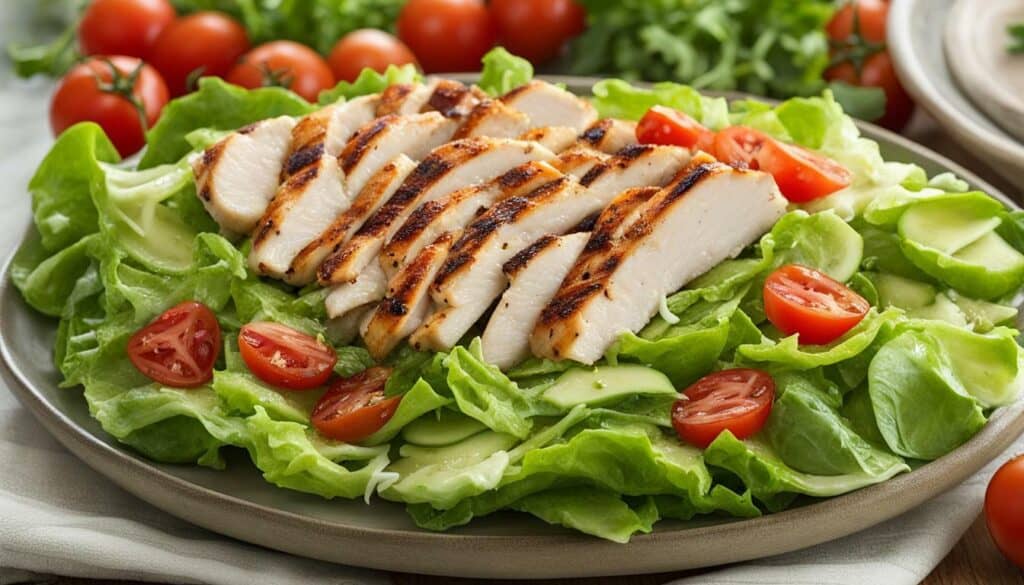
| Nutrient | Amount per 100g |
|---|---|
| Carbohydrates | 5g |
| Protein | 12g |
| Fat | 14g |
| Sugar | 1g |
| Calcium | 150mg |
| Iron | 0.72mg |
Discover a Healthier Way to Enjoy Your Chicken Caesar Salad
Ready to discover a healthier way to enjoy your Chicken Caesar Salad? Let’s explore low-carb options and creative ingredient choices. A Chicken Caesar Salad typically contains 5 grams of carbohydrates per 100 grams, making it a suitable choice for those watching their carb intake. With 12 grams of protein, 14 grams of fat, and 1 gram of sugar, this salad offers a balanced macronutrient profile.
One simple modification to reduce the calorie and fat content is to use low-fat dressing or reduce the amount of dressing used. Opting for grilled chicken instead of fried can also make a significant difference. By making these small adjustments, you can enjoy a lighter and healthier version of your beloved Chicken Caesar Salad.
It’s important to note that some restaurant versions of the Caesar Salad may have higher calorie and fat content. To make an informed choice, always check the nutrition information provided by the establishment. This way, you can ensure that your Chicken Caesar Salad aligns with your dietary goals.
Overall, a Chicken Caesar Salad can be a delicious and healthy meal option when mindful choices are made. By selecting low-carb ingredients, being conscious of the dressing and cooking method, and checking nutrition information when dining out, you can create a diet-friendly and satisfying meal. So go ahead, indulge in a flavorful Chicken Caesar Salad with confidence!
FAQ
Q: How many carbohydrates are in a Chicken Caesar Salad?
A: A Chicken Caesar Salad typically contains 5 grams of carbohydrates per 100 grams.
Q: What is the nutritional profile of a Chicken Caesar Salad?
A: A Chicken Caesar Salad provides 12 grams of protein, 14 grams of fat, and 1 gram of sugar per 100 grams. It is also a good source of calcium and iron, with 150 milligrams and 0.72 milligrams, respectively.
Q: How can I make a Chicken Caesar Salad healthier?
A: You can make a Chicken Caesar Salad healthier by using low-fat dressing, reducing the amount of dressing used, or opting for grilled chicken instead of fried.
Q: Are restaurant versions of the Caesar Salad always healthy?
A: Restaurant versions of the Caesar Salad may have higher calorie and fat content, so it’s important to check the nutrition information to make mindful choices.
Q: What are the benefits of a Chicken Caesar Salad?
A: A Chicken Caesar Salad is a good source of protein, calcium, and iron, making it a nutritious meal option.
Q: How can I make a Chicken Caesar Salad keto-friendly?
A: To make a Chicken Caesar Salad keto-friendly, you can use low-carb dressing, remove croutons, and add keto-friendly toppings like avocado or bacon.
Q: Is a Chicken Caesar Salad suitable for a diet-friendly meal plan?
A: Yes, a Chicken Caesar Salad can be incorporated into a diet-friendly meal plan due to its balanced macronutrient profile.
Q: What is a low-carb alternative for a Chicken Caesar Salad?
A: A low-carb alternative for a Chicken Caesar Salad can be made by replacing croutons with roasted vegetables or using lettuce wraps instead of a traditional salad base.
Q: What are some creative ways to enjoy a Chicken Caesar Salad?
A: You can get creative with a Chicken Caesar Salad by adding different toppings like grilled shrimp or sliced strawberries for a refreshing twist.
How Many Net Carbs Are in Refried Beans Compared to a Chicken Caesar Salad?
When comparing the net carbs in refried beans to a chicken Caesar salad, it’s evident that the former contains a higher amount. While the salad focuses on low-carb options, refried beans can be relatively high in net carbs due to their starch content. It’s important to consider portion size and individual dietary goals when making choices between these two dishes.

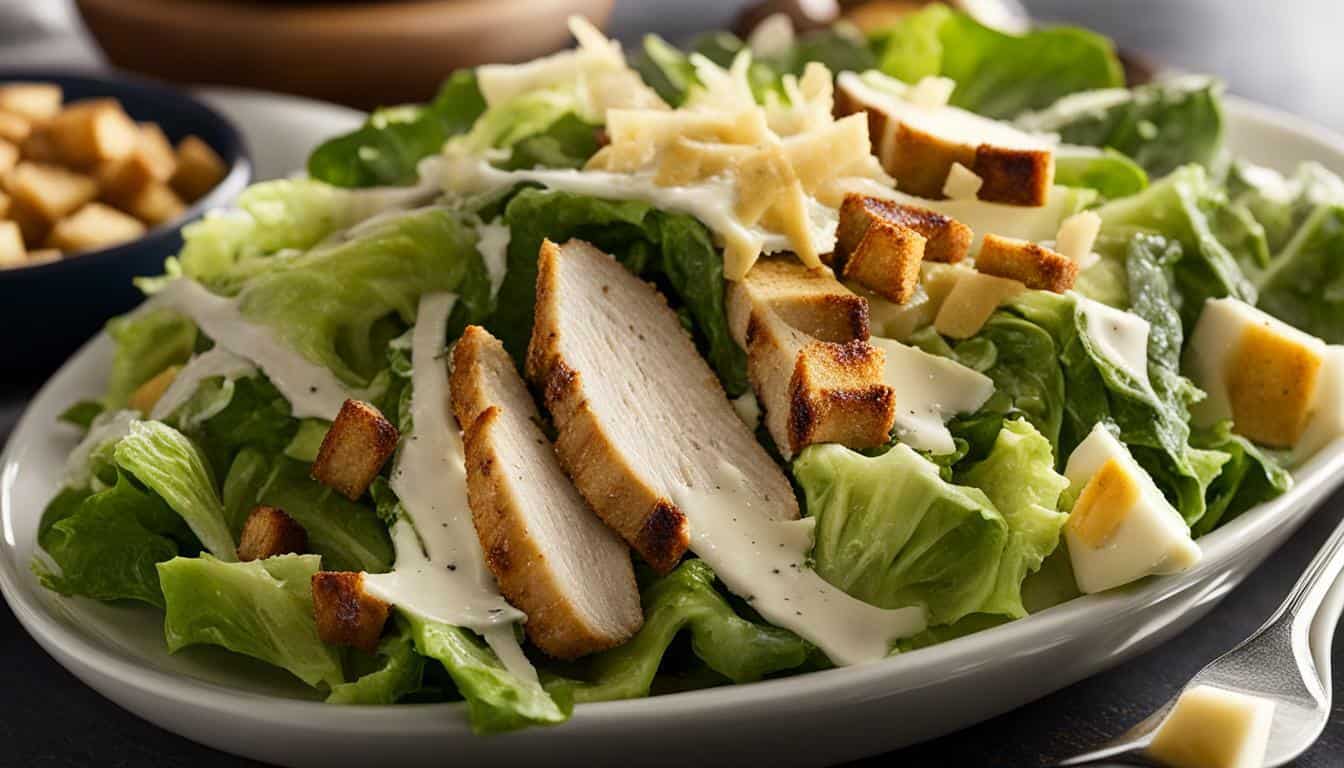



Leave a Reply